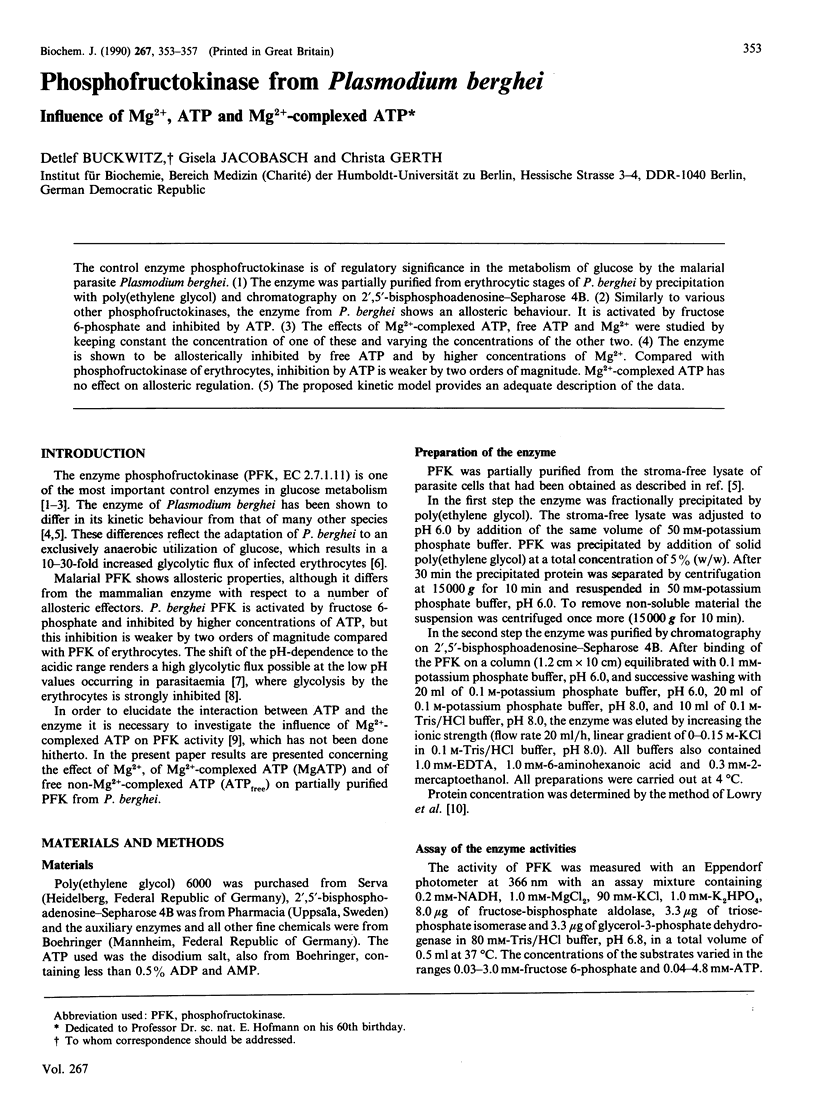Abstract
The control enzyme phosphofructokinase is of regulatory significance in the metabolism of glucose by the malarial parasite Plasmodium berghei. (1) The enzyme was partially purified from erythrocytic stages of P. berghei by precipitation with poly(ethylene glycol) and chromatography on 2',5'-bisphosphoadenosine-Sepharose 4B. (2) Similarly to various other phosphofructokinases, the enzyme from P. berghei shows an allosteric behaviour. It is activated by fructose 6-phosphate and inhibited by ATP. (3) The effects of Mg2(+)-complexed ATP, free ATP and Mg2+ were studied by keeping constant the concentration of one of these and varying the concentrations of the other two. (4) The enzyme is shown to be allosterically inhibited by free ATP and by higher concentrations of Mg2+. Compared with phosphofructokinase of erythrocytes, inhibition by ATP is weaker by two orders of magnitude. Mg2(+)-complexed ATP has no effect on allosteric regulation. (5) The proposed kinetic model provides an adequate description of the data.
Full text
PDF




Selected References
These references are in PubMed. This may not be the complete list of references from this article.
- Atha D. H., Ingham K. C. Mechanism of precipitation of proteins by polyethylene glycols. Analysis in terms of excluded volume. J Biol Chem. 1981 Dec 10;256(23):12108–12117. [PubMed] [Google Scholar]
- Atkins G. L. Tests for the goodness of fit of models. Biochem Soc Trans. 1976;4(2):357–361. doi: 10.1042/bst0040357. [DOI] [PubMed] [Google Scholar]
- Buckwitz D., Jacobasch G., Break M. Estimating the degree of infection of Plasmodium berghei infected red blood cells by evaluation of pyruvate kinase activity. Dis Markers. 1989 Oct-Dec;7(4):229–238. [PubMed] [Google Scholar]
- Buckwitz D., Jacobasch G., Gerth C., Holzhütter H. G., Thamm R. A kinetic model of phosphofructokinase from Plasmodium berghei. Influence of ATP and fructose-6-phosphate. Mol Biochem Parasitol. 1988 Jan 15;27(2-3):225–232. doi: 10.1016/0166-6851(88)90041-2. [DOI] [PubMed] [Google Scholar]
- CLELAND W. W. The kinetics of enzyme-catalyzed reactions with two or more substrates or products. I. Nomenclature and rate equations. Biochim Biophys Acta. 1963 Jan 8;67:104–137. doi: 10.1016/0006-3002(63)91800-6. [DOI] [PubMed] [Google Scholar]
- COHN M. MAGNETIC RESONANCE STUDIES OF METAL ACTIVATION OF ENZYMIC REACTIONS OF NUCLEOTIDES AND OTHER PHOSPHATE SUBSTRATES. Biochemistry. 1963 Jul-Aug;2:623–629. doi: 10.1021/bi00904a001. [DOI] [PubMed] [Google Scholar]
- Cronin C. N., Tipton K. F. Kinetic studies on the reaction catalysed by phosphofructokinase from Trypanosoma brucei. Biochem J. 1987 Jul 1;245(1):13–18. doi: 10.1042/bj2450013. [DOI] [PMC free article] [PubMed] [Google Scholar]
- Cronin C. N., Tipton K. F. The roles of magnesium ions in the reaction catalysed by phosphofructokinase from Trypanosoma brucei. Biochem J. 1987 Oct 1;247(1):41–46. doi: 10.1042/bj2470041. [DOI] [PMC free article] [PubMed] [Google Scholar]
- Fordyce A. M., Moore C. H., Pritchard G. G. Phosphofructokinase from Streptococcus lactis. Methods Enzymol. 1982;90(Pt E):77–82. doi: 10.1016/s0076-6879(82)90109-4. [DOI] [PubMed] [Google Scholar]
- Hanson R. L., Rudolph F. B., Lardy H. A. Rabbit muscle phosphofructokinase. The kinetic mechanism of action and the equilibrium constant. J Biol Chem. 1973 Nov 25;248(22):7852–7859. [PubMed] [Google Scholar]
- Hofmann E., Kopperschläger G. Phosphofructokinase from yeast. Methods Enzymol. 1982;90(Pt E):49–60. doi: 10.1016/s0076-6879(82)90106-9. [DOI] [PubMed] [Google Scholar]
- Hofmann E. The significance of phosphofructokinase to the regulation of carbohydrate metabolism. Rev Physiol Biochem Pharmacol. 1976;75:1–68. doi: 10.1007/BFb0030484. [DOI] [PubMed] [Google Scholar]
- Ingham K. C. Protein precipitation with polyethylene glycol. Methods Enzymol. 1984;104:351–356. doi: 10.1016/s0076-6879(84)04101-x. [DOI] [PubMed] [Google Scholar]
- Kotlarz D., Buc H. Phosphofructokinases from Escherichia coli. Methods Enzymol. 1982;90(Pt E):60–70. doi: 10.1016/s0076-6879(82)90107-0. [DOI] [PubMed] [Google Scholar]
- LOWRY O. H., ROSEBROUGH N. J., FARR A. L., RANDALL R. J. Protein measurement with the Folin phenol reagent. J Biol Chem. 1951 Nov;193(1):265–275. [PubMed] [Google Scholar]
- MONOD J., WYMAN J., CHANGEUX J. P. ON THE NATURE OF ALLOSTERIC TRANSITIONS: A PLAUSIBLE MODEL. J Mol Biol. 1965 May;12:88–118. doi: 10.1016/s0022-2836(65)80285-6. [DOI] [PubMed] [Google Scholar]
- Marschke C. K., Bernlohr R. W. Phosphofructokinase from Bacillus licheniformis. Methods Enzymol. 1982;90(Pt E):70–77. doi: 10.1016/s0076-6879(82)90108-2. [DOI] [PubMed] [Google Scholar]
- Mavis R. D., Stellwagen E. The role of cations in yeast phosphofructokinase catalysis. J Biol Chem. 1970 Feb 25;245(4):674–680. [PubMed] [Google Scholar]
- Noat G., Ricard J., Borel M., Got C. Kinetic study of yeast hexokinase. Inhibition of the reaction by magnesium and ATP. Eur J Biochem. 1970 Apr;13(2):347–363. doi: 10.1111/j.1432-1033.1970.tb00937.x. [DOI] [PubMed] [Google Scholar]
- O'SULLIVAN W. J., PERRIN D. D. THE STABILITY CONSTANTS OF METAL-ADENINE NUCLEOTIDE COMPLEXES. Biochemistry. 1964 Jan;3:18–26. doi: 10.1021/bi00889a005. [DOI] [PubMed] [Google Scholar]
- Otto M., Heinrich R., KUHN B., Jacobasch G. A mathematical model for the influence of fructose 6-phosphate, ATP, potassium, ammonium and magnesium on the phosphofructokinase from rat erythrocytes;. Eur J Biochem. 1974 Nov 1;49(1):169–178. doi: 10.1111/j.1432-1033.1974.tb03822.x. [DOI] [PubMed] [Google Scholar]
- Pettigrew D. W., Frieden C. Binding of regulatory ligands to rabbit muscle phosphofructokinase. A model for nucleotide binding as a function of temperature and pH. J Biol Chem. 1979 Mar 25;254(6):1887–1895. [PubMed] [Google Scholar]
- Phillips R. C., George P., Rutman R. J. Thermodynamic studies of the formation and ionization of the magnesium(II) complexes of ADP and ATP over the pH range 5 to 9. J Am Chem Soc. 1966 Jun 20;88(12):2631–2640. doi: 10.1021/ja00964a002. [DOI] [PubMed] [Google Scholar]
- Sander B. J., Lowery M. S., Kruckeberg W. C. Plasmodium berghei: acid-insensitive phosphofructokinase in infected mouse erythrocytes. Exp Parasitol. 1982 Feb;53(1):11–16. doi: 10.1016/0014-4894(82)90087-x. [DOI] [PubMed] [Google Scholar]
- Storey K. B. Phosphofructokinase from oyster adductor muscle. Methods Enzymol. 1982;90(Pt E):39–44. doi: 10.1016/s0076-6879(82)90104-5. [DOI] [PubMed] [Google Scholar]


